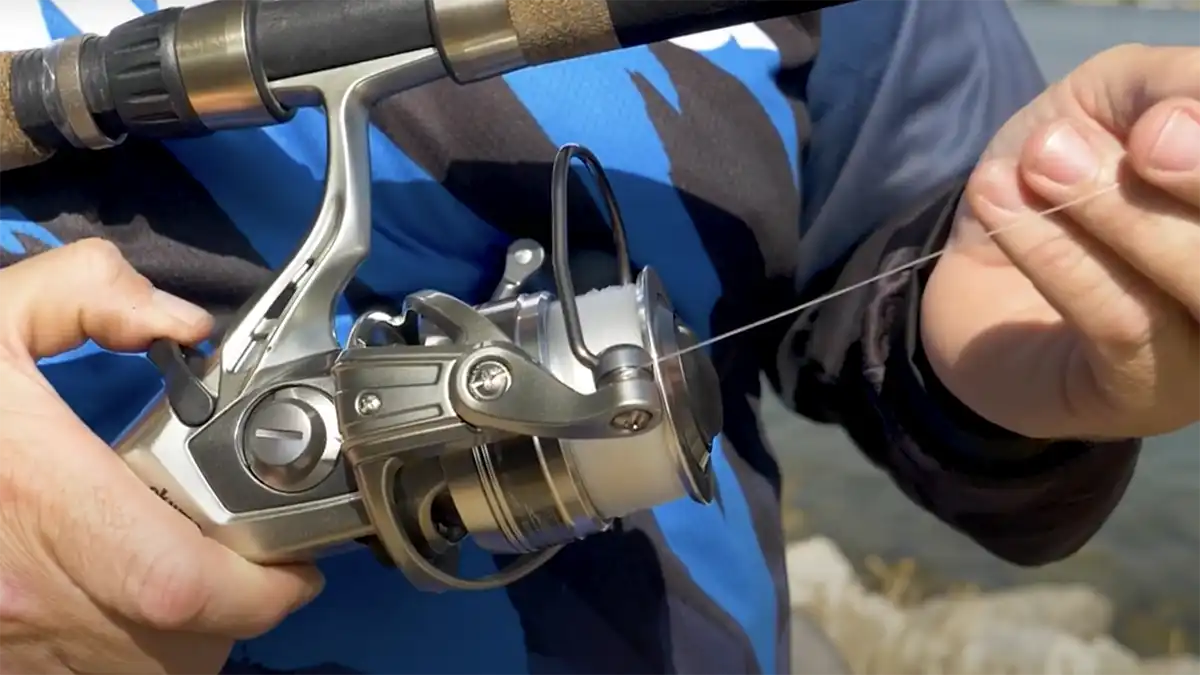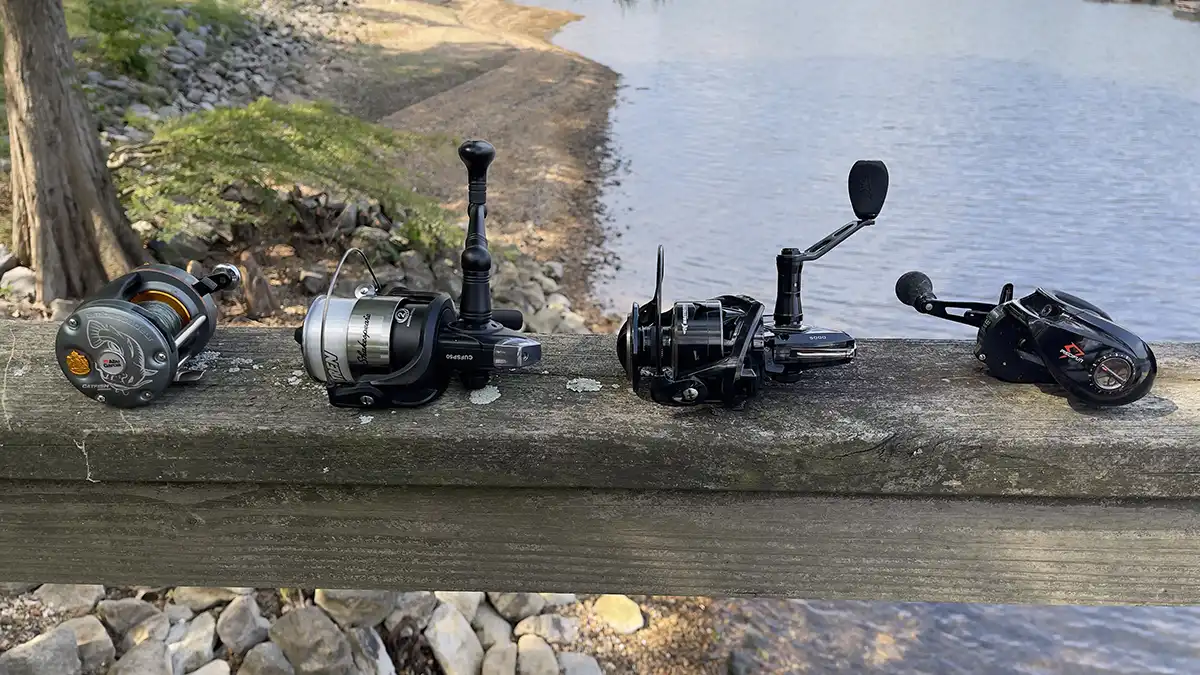Selecting the best catfish reel for a trip is an important decision, since these battlers will test your equipment to the max. Their strength and endurance are legendary and it’s magnified even further if you’re fishing in current.
When selecting gear, you need to know two things. What species you’re after and the conditions you’re likely to face. You’ll find great catfishing for one or more of your favorite species in small farm ponds on up to our largest rivers. If you’re going down to the “back 40” pond to catch a few eating-sized channel cats or trying a local creek, the simplest reel will work just fine. The legendary Zebco 33 and its upsized cousin, the Zebco 404, have pulled in millions of cats. Though original models qualify as valued antiques, you can get new versions of these push-button models for under $20! On larger creeks and for distance casting, spinning setups with a 2500-sized reel work great. While it’s a little cumbersome to release line from push-button models, flipping the bail allows you to drift a bait downstream in current, or launch a cast out into the depths of a larger community pond. Here you will also find our list of the best catfish rods.
OUR PICKS FOR BEST CATFISH REELS
- BEST LINE COUNTER CATFISH REEL: Shimano Tekota Line Counter Reel [Buy from Bass Pro]
- BEST BAIT-RUNNER CATFISH REEL: Okuma Ceymar Baitfeeder Spinning Reel [Buy from Amazon]
- BEST TAILRACE REEL: Shimano BaitRunner OC Spinning Reel [Buy from Bass Pro]
- BEST DRIFT FISHING REEL: Abu Garcia Ambassadeur Catfish Special [Buy from Bass Pro]

CATFISH REELS FOR FLOAT-FISHING AND DRIFTING
Floats are overlooked tools for river catfish, especially big channel cats and some flatheads. A narrow-bodied bobber carries your bait downstream past many places where catfish may have holed up. If you set the float the right distance from the bottom you’ll avoid most of the snags that plague river anglers. Keep working a potentially good area from shore or anchor position, since the scent of your cutbait, stinkbait, or livebait will get nearby catfish in the mood to feed. They may swim upstream to intercept the float and take it down. Also, see our article on the best catfish bait.
Spinning tackle with a long rod allows you to get a good drift by gradually releasing line by flipping the bail open then closing it. Pause and continue until it’s drifted too far. Reel up and try another drift. Baitcasting gear works well too with a quick button push release and handle turn. Line capacity is the name of the game here.
Choose a reel to match the size of catfish you’re likely to catch–a 2500-size for creeks less than 50 yards across, and up to 4000-size for 300-yard across stretches of moderately-sized rivers, where channel cats may exceed 10 or 12 pounds. Flatheads also call for heavy-duty saltwater gear in the spinning line, at least 4000-size, matched with a long stout rod to pull them out of the brushy spots they like.
Quality reels of this sort are available from dozens of manufacturers, with costs commonly running from $40 to over $300. In my opinion, save your money on top end spinning reels and go with solid lower-priced models that feature a strong drag and smooth bail operation as well as substantial spool capacity. There are many options available for under $125. Check out models from Lew’s, Pflueger, Shimano, 13 Fishing, Abu Garcia, KastKing, Daiwa, Bass Pro Shops, Ugly Stik, Piscifun and more.
Abu Garcia Ambassadeur Catfish Special
For Baitcasters the Abu Garcia Ambassadeur Catfish Special is a solid option.
On big reservoirs, another long-distance presentation involves drifting across promising structure. Use your trolling motor combined with the wind to move you along while you monitor sonar to spot groups of fish. Reservoir blue cats sometimes mix with channel cats. Drifting can produce a mixed bag of medium-sized fish when using with cutbait or punchbaits. Some spots may be over 40 feet deep so you need a large spool capacity, whether you prefer baitcasting or spinning tackle. Releasing a lot of line helps keep your bait near the bottom where most cats feed. At times, blues hold well above bottom. Be sure to monitor your sonar and adjust lines to match their depth.

BAIT-WALKING CATFISH REELS
In big rivers, one of the most effective techniques for catching blue cats is “bait-walking”. This involves using the current to gradually push your big slab of cutbait downstream from an anchor position. This technique allows you to cover a long stretch of water. Extra-heavy rods and big baitcasting reels have the line capacity and hook-setting power to fish a 75-yard stretch which allows you to explore every hole and rockpile. Spots may be more than 40 feet deep, so you need some serious beef to set the hook and work a 50-pound fish to the net.
Shimano Tekota Line Counter Reel
Matched with 50- to 80-pound braid, heavy-duty mills like Shimano’s Tekota Line Counter (LC) models excel. The line-counter feature allows you to keep track of the amount of line you have out; this is important to know when trying to pinpoint key deepwater spots. Additionally, the counter tells you when the rig is so far downstream that you’ll have a hard time setting the hook and keeping a fish under control. The 300 LC weighs 14 ounces and holds 205 yards of 50-pound braid. Take a step up to the 500 and 600LCs that hold 350 yards of 65-pound and weigh just a few once more. Equipped with a super smooth draw, these beauties are ideal for heavy-duty applications. They’re fairly priced under $250.
Other options include Okuma’s Cold Water, a low-profile line-counter reel that fits the hand more easily than the big round models. It’s a little smaller (12.5 ounces) with a little less line capacity but retails under $200. Daiwa’s Lexa is available in 100- 300- and 400-sizes, with optional line-counter features. The larger sizes are equipped with an oversized metal handle with foam grip to add torque to your side of the battle. They generally run from $200-$300+, depending on model and retailer. For a tough top-quality reel at a great price, check Abu Garcia’s Ambassadeur SX6600. It has a big spool, brass gearing and weighs just over 11 ounces—$99.95.
Some veteran catmen favor a baitcaster with a flippin’ switch that allows you to disengage the spool to release line, then immediately engage the spool to stop the bait from drifting further downstream. It saves time and extra movement when bottom-bumping because you’re continually releasing more line, then stopping the spool. KastKing’s new MegaJaws Elite Baitcaster has this feature for around $130.

CATFISH BAIT-RUNNERS
At times, you need to allow fish to pull the bait away before setting the hook since finicky fish may drop a bait if there’s pressure. Spinning reels called baitfeeders or baitrunners allow line to be smoothly pulled from the spool. There’s no need to fool with the bail, just flip the switch to lock the spool and set the hook. Many saltwater anglers who fish from piers, jetties, and beaches use these for the big marine fish that patrol just off the surfline, like black and red drum, snook, roosterfish, striped bass, and of course, sharks.
Okuma Ceymar Baitfeeder Spinning Reel
Several models are available that work great for big cats as well. Okuma’s Ceymar Baitfeeder Spinning Reel is a real solid one, and priced at just $69. The Model 55 is a beast at 16 ounces with a 4.5:1 gear ratio for power cranking, holding 240 yards of 50-pound braid. It has a power handle with special grips for comfort and a firm grasp. KastKing’s Sharky III model is in the same price range, in 3 sizes–4000, 5000, and 6000. It has a potent carbon-fiber drag and CNC aluminum spool.
Shimano Baitrunner OC Spinning Reel
Shimano’s Baitrunner is the Cadillac of the category. Offered in 3 sizes, ranging from $190 to $260. The 4000 weighs just 13.5 ounces, but holds 270 yards of 50-pound braid. It’s hard to beat the smoothness of a Shimano spinning mill. Shimano Baitrunner OC Spinning Reels are available at:

TAILRACE CATFISH REEL SELECTIONS
Catfish of all species often gather in the fast waters below dams on rivers, large and small. The instinct to migrate, as well as current draws baitfish toward these areas, providing prime feeding grounds for catfish and many other predators. Most tailraces offer deeper pools below the dam, many that were present before construction, others hollowed out by decades of water pouring over the area.
They’re not easy to fish by boat or from shore, but they provide bank anglers with a unique opportunity to cast into prime water on major rivers, where they may tangle with big stripers and hybrids, as well as big blues and flatheads.
On bigger river systems, distance is key, so big spinning reels–4000 or 5000-size with lots of line capacity are in order. Big fish know how to use current to their advantage, so while you might land a 40-pound blue cat in 15 minutes in a reservoir, it might take 35 in a tailrace, as the fish pulls line against even a tight drag.
Fishing from rocky shorelines or riprap can beat up your reels fast. Where possible, use rod holders to keep your outfit off the ground. Even so, it’s wise to select tough reels with aluminum spools and side plates, as they can take a beating and still perform well. Hang on and have fun!












